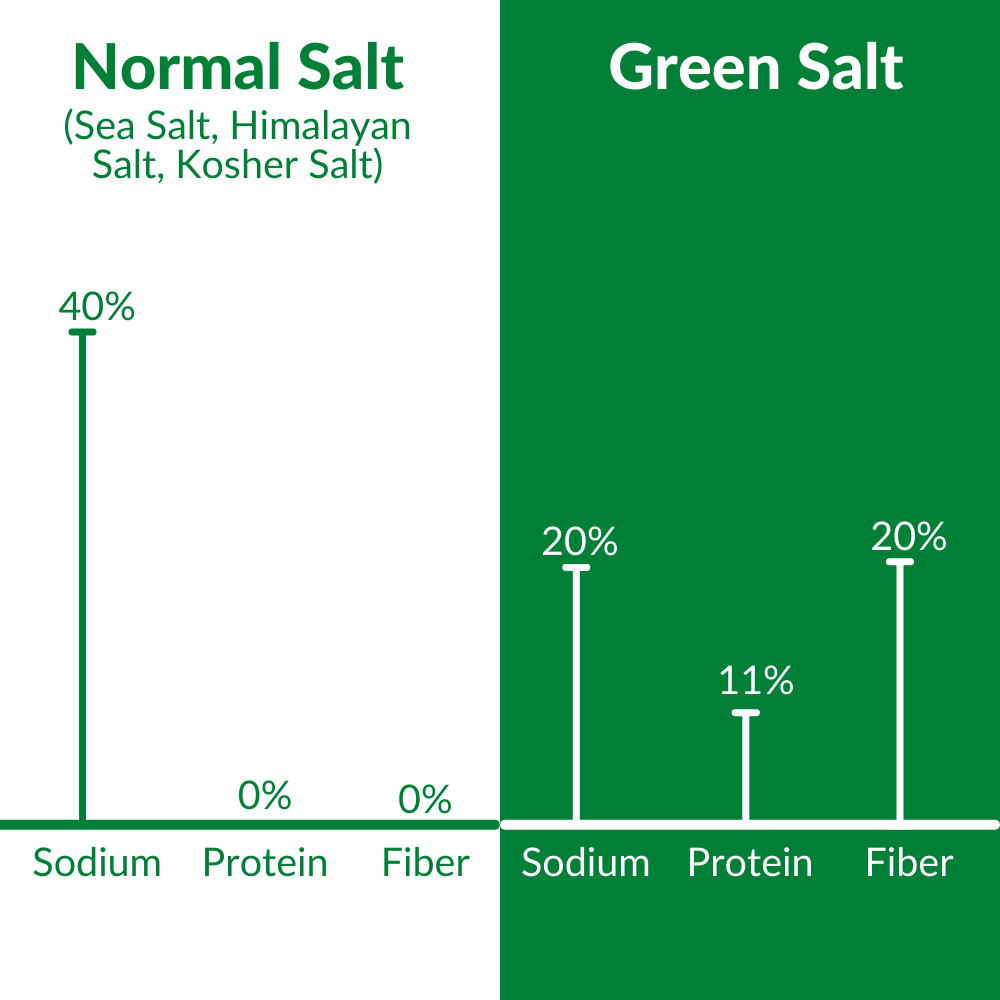What's Green Salt and can it improve your heart health?
Green Salt (left) Salicornia (right)
Many people have heard of pink Himalayan salt, and some know about black salt, but what's Green Salt?
The #1 food project on Kickstarter in May 2021, Green Salt is a new plant-based salt alternative that’s low sodium and better for your heart health. It’s also rich in Magnesium, Potassium, and Vitamin B3.
How does it do all that? Green Salt is made from 100% dehydrated Salicornia, an asparagus-like superfood that grows by the sea.
What's wrong with salt?

"What’s wrong with salt?" you might ask. Salt’s chemical makeup is sodium chloride. Sodium is necessary for our cells to function correctly. However, just like most things, consuming sodium in excess can cause health problems.
According to the FDA and WHO, we consume 50% more sodium daily than necessary. Eating too much sodium can lead to high blood pressure, which is the most important risk factor for stroke and heart disease (FDA.gov 2021).
American Cardiological Society statistics showed that nearly 1 in 2 US adults have high blood pressure. The high blood pressure pandemic is bigger than Covid!

International Society of Hypertension
Can Green Salt help end the high blood pressure pandemic?
Green Salt has 50% less sodium than salt by weight. Despite being low in sodium, third party sensory studies have demonstrated that it has the same relative saltiness as salt due to its diverse mineral content.
Not only that, Green Salt contains magnesium and potassium, which have been demonstrated to help regulate blood pressure. It also adds an umami flavor which enhances the flavors of your food.
The World Health Organization estimates that if we reduce sodium intake to recommended levels, 2.5 million deaths can be prevented every year! By reducing sodium intake, Green Salt has the potential to save millions of lives a year.

Percentages by weight (Green Salt is also high in protein and fiber!)
What is Salicornia?

Green Salt’s ingredient, Salicornia, belongs to the same family as quinoa and amaranth. It’s a vegetable that grows along the coasts of North America, Europe, and Asia.
Its delicious salty taste has made it popular with chefs all over the world. Salicornia has also been demonstrated to have numerous health benefits.
- Several studies have identified antioxidant (Kim 2009), anti‐inflammatory (Kang 2013), antidiabetic (Park 2006), and anticancer activities (Kong 2008).
- (Zhang 2015) investigated the effects of salt derived from Salicornia on blood pressure in rats. Notably, the results showed that, while common salt induced high blood pressure, the Salicornia salt did not. Despite both groups of rats receiving the same amount of sodium, the salicornia rats were protected against hypertension and oxidative stress.
How is Green Salt made?
Meet the co-founders of Green Salt: Paul, Erick, Irving, and Chris
The Green Salt team is the first commercial producer of Salicornia in the world. They began growing Salicornia as part of a research project cultivating sustainable crops.
On the coast of Baja California, they grow the highest quality Salicornia using filtered sea water and organic farming practices. To make Green Salt, they dehydrate Salicornia using solar power to preserve the maximum amount of nutrients, then grind it into a powder.
If you want to improve your heart health, Green Salt may be a good alternative for you. You can use Green Salt to replace salt in any dish!
What have people said about Green Salt?
"It adds a nice touch of vegetal flavor when dusted atop a deviled egg, baked potato or sautéed fish." - Florence Fabricant (NY Times Food Critic)
"Tastes like salt and I actually like it more than regular salt!" @thatbilloakley, Bill Oakley, Simpsons TV writer and "The Gordon Ramsay of Fast Food"
"Green Salt is the perfect option for people looking to reduce sodium intake and look out for their cardiovascular health" -Carolina Lavandera, Nutritionist
References
- Kang H, Koppula S, Park TK. 2013. Salicornia bigelovii Torr attenuates neuro‐inflammatory responses in lipopolysaccharide‐induced BV‐2 microglia by regulation of NF‐kappa B signaling. Trop J Pharm Res 12(6): 897– 903.
- Kim YA, Kong CS, Um YR, Lim SY, Yea SS, Seo Y. 2009. Evaluation of Salicornia herbacea as a potential antioxidant and anti‐inflammatory agent. J Med Food 12(3): 661– 8.
- Kong CS, Kim YA, Kim MM, Park JS, Kim JA, Kim SK, Lee BJ, Nam TJ, Seo Y. 2008. Flavonoid glycosides isolated from Salicornia herbacea inhibit matrix metalloproteinase in HT1080 cells. Toxicol In Vitro 22(7): 1742– 8.
- Zhang S, Wei M, Cao C, Ju Y, Deng Y, Ye T, Xia Z, Chen M. 2015. Effect and mechanism of Salicornia bigelovii Torr plant salt on blood pressure in SD rats. Food Funct 6(3): 920– 6.

